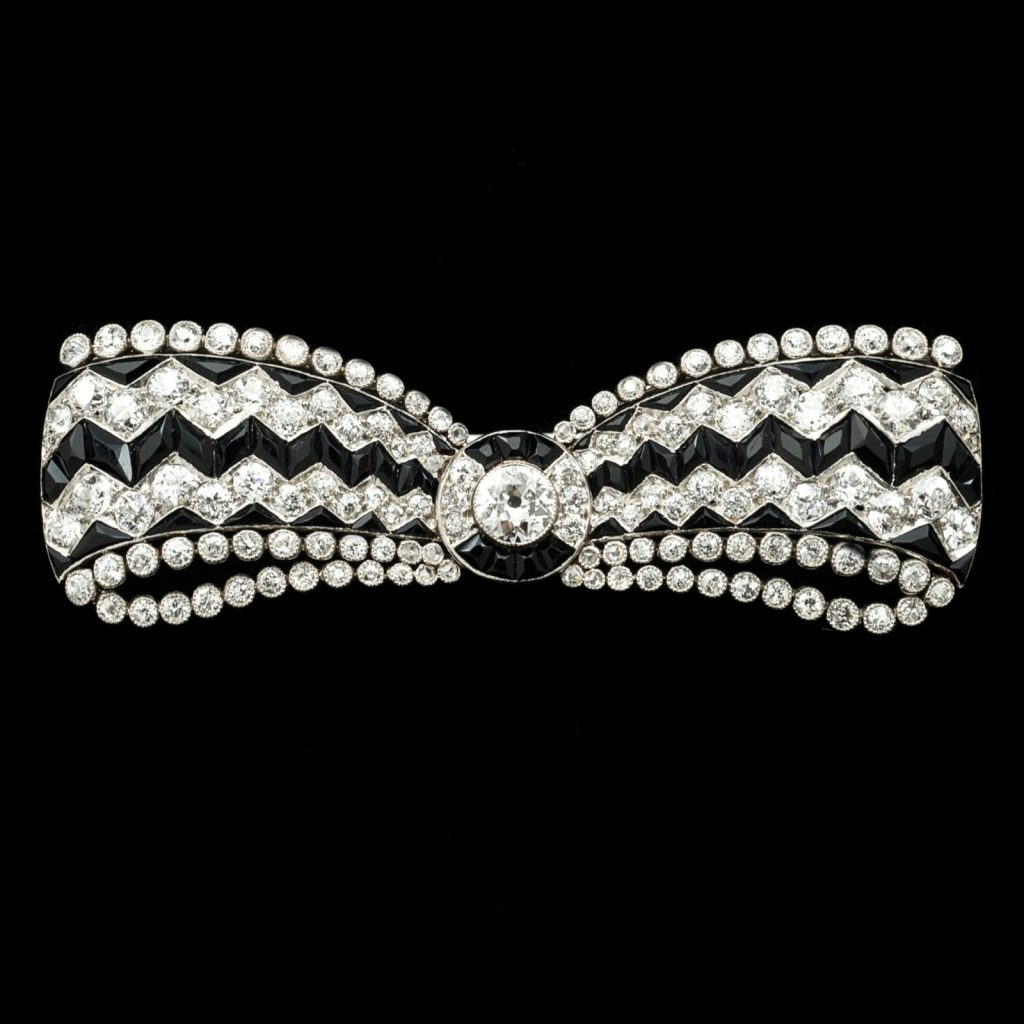The House of Cartier – Family business to International Brand

Above: Cartier onyx & diamond bow brooch c.1930
In 1847 Louis Cartier opened a small jewellery store in Paris.
In 1870 his son Alfred assumed leadership and organised the first exhibition in London.
In I898 his son Louis joined his father Alfred.
In 1898 Alfred’s sons Pierre and Jacques joined the company.
In 1899 the store moved to 13 Rue de la Paix, Paris.
Louis supervised design and production.
Pierre travelled to Russia to commission pieces from the Faberge workshops and make important social contacts.
Jacques moved to London and in 1909 opened Cartier in New Bond Street, and in the same year Pierre opened Cartier at 712 Fifth Avenue New York.
All three brothers were great travellers to exotic countries like India and Egypt and brought back influences and designs from other cultures, while making important social contacts and clients. After the discovery of Tutankhamen’s tomb in 1922 there was a vogue for Egyptian design – including scarabs, Horus, and sacred rams.
France’s involvement with Indo-China had brought to Paris many Oriental craftsmen and jewellers – specialists in enamel, lacquer work and inlay. Cartier patronised their ateliers and the firm’s designers were inspired by traditional Chinese and Japanese design, which became extremely fashionable during the 1920’s and 1930’s.
Jacques sourced pearls in the Persian Gulf and developed a reciprocal trade with India, collecting precious stones with the help of his agent in New Delhi, who also sent back to Paris original Moghul pieces for design or remounting.
Louis had the imagination and foresight to employ new young designers. In 1909 he hired a young graduate from the Ecole des Arts Decoratifs, Charles Jacqueau, who designed a collection based on Persian Indian and Tibetan designs. For 25 years he directed a team of 11 designers and established Cartier’s international reputation for elegance and refinement.
The following year he hired a young woman, Jeanne Toussaint, to share his responsibilities as head of the firm, a position she retained for 50 years until 1960. She had a modern approach to the 20th century woman, and was made Head of Fine Jewellery in 1933.
Cartier’s Stand at the great EXHIBITION DES ARTS DECORATIFS, PARIS, in 1925 created enormous interest and heralded the new Art Deco style which persisted until the second World War. Jeanne Toussaint and Charles Jacqueau devised the classic geometric Art Deco style, sometimes influenced by Indian, Egyptian and Moghul designs. They created jewels with unusual combinations of gemstones, showing coloured gemstones – ruby, sapphire and emerald, onyx, aquamarine and citrine, delineating the design against diamonds.
The quality and consistency of Cartier’s production in the first half of the 19th century was unequalled and the three shops in Paris, London and New York attracted a glamorous clientele including British and European royalty and aristocracy, style icons and movie stars.
The years after WW11 saw a decline of the business and the big stores were sold – New York in 1962, Paris and London in 1965. In 1972 the investment group Robert Hocq, Joseph Kanoui and Alain Perrin purchased the name, created a reunion of the three stores in Paris, London and New York and developed the mass production line Les Must de Cartier, starting the famous international brand with 200 shops in 125 countries in the world.
Cartier has successfully promoted the brand with big Exhibitions of their wonderful archival collection of important historical and iconic pieces. The first retrospective exhibition was held in Monte Carlo on 1975 – Louis Cartier – ART DECO MASTERPIECES and in Lausanne, Switzerland in 1996 – CARTIER- SPLENDOURS OF JEWELLERY.
In Australia we were privileged to see many of the most important and exquisite jewels made in the 1920’s and 1930’s at the Australian National Gallery in Canberra in 2018 as part of the international tour of the CARTIER Exhibition.
